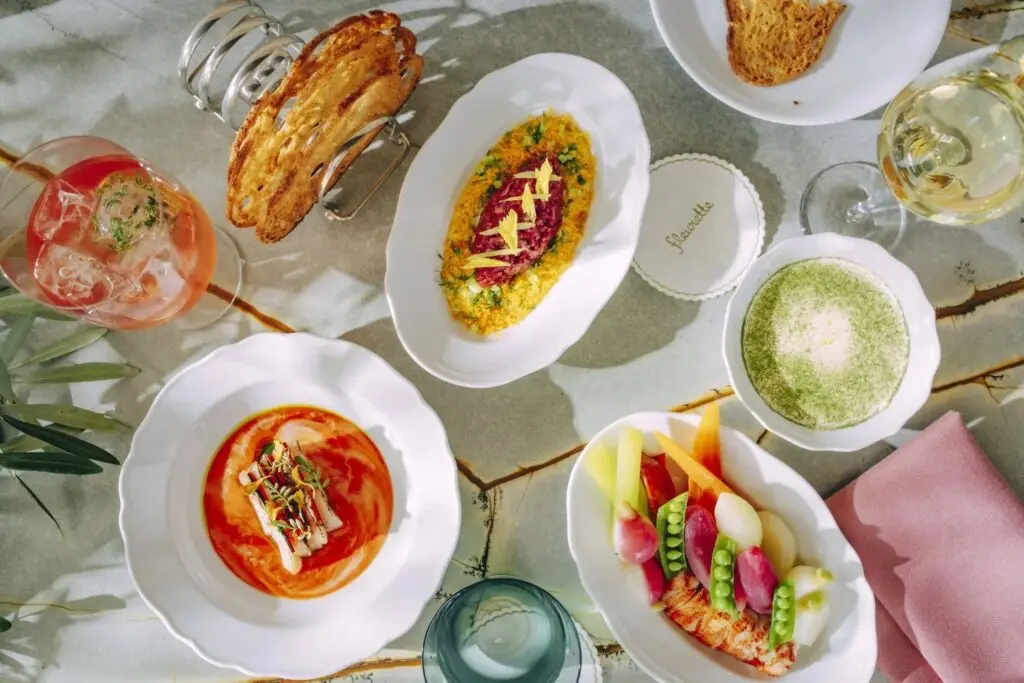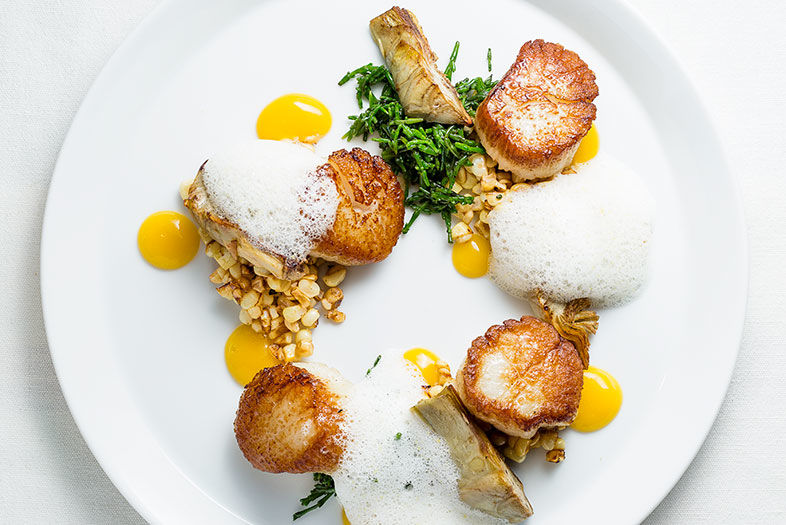Bistro du Marché
7437 Girard Avenue,
La Jolla
Best Dishes
Ravioli aux Champignons
Beef Tenderloin au Poivre
île flottante dessert
My water glass nearly became empty one time. The jazz music is a tad low, and that seems like a tepid endorsement of the genre. I wish it were Charles Mingus. A heat wave has hit San Diego this evening and the room is a tad warm, so I’m forced to ask the server to turn on the air conditioning (he politely does so immediately). With only one maddening road in and out, traffic and psychotic breaks are always a risk. I wish the wine were free. The wine could be free.
These are the sum of my complaints about Bistro du Marché. In over a decade of reviewing restaurants, I’ve never struggled to find a fault. I’m paid for unemotional honesty, hopefully dispensed with tact. A perfect night of dinner service is a unicorn. Restaurant kitchens are a natural habitat for all species of errors. They are chaotic mechanisms, operated by the most imperfect of machines—people. There is always an under-seasoned dish, a lack of acid, an overcooked protein, a broken sauce, an awkward presentation, spotty service, something.
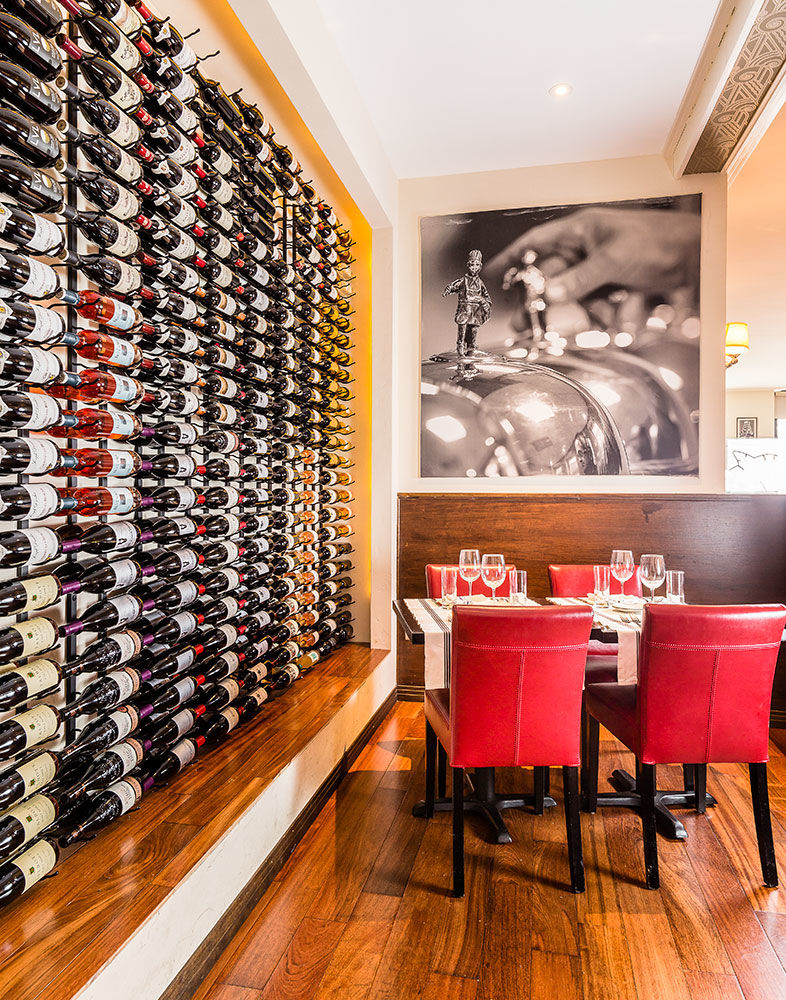
Tapenade’s Sterling French Reputation Remains Near-Perfect at Bistro Du Marché
Justin McChesney-Wachs
Over two visits, Bistro du Marché by Tapenade was as near-perfect a restaurant as I’ve experienced. Under-attended, maybe, and a little lonely. Admittedly, I visited them on a Monday and Tuesday night, when most dining rooms are barren. But the service and the food—dish after dish after drink after dish—were impeccable, inspiring, minor revelations. Maybe the creamed spinach could’ve had a bit more salt. Maybe.

Tapenade’s Sterling French Reputation Remains Near-Perfect at Bistro Du Marché
Chef-owner Jean-Michel Diot and co-owner wife Sylvie
Meals this good are always shocking, but less so when Jean-Michel Diot is involved. Bistro du Marché’s French chef-owner started his career at a slew of two- and three-star Michelin restaurants in his native country (Restaurant Magnard, La Pyramide, Restaurant Jacqueline Fenix, Les Pres d’Eugenie) before landing his first head chef gig at Le Royal Gray, where he earned two Michelin stars of his own. He moved to New York in 1987 to open Maxim’s de Paris, then got a three-star review from the New York Times at his next stop, Park Bistro, before finishing his NYC career at the estimable Les Halles and Brasseries des Theatres.
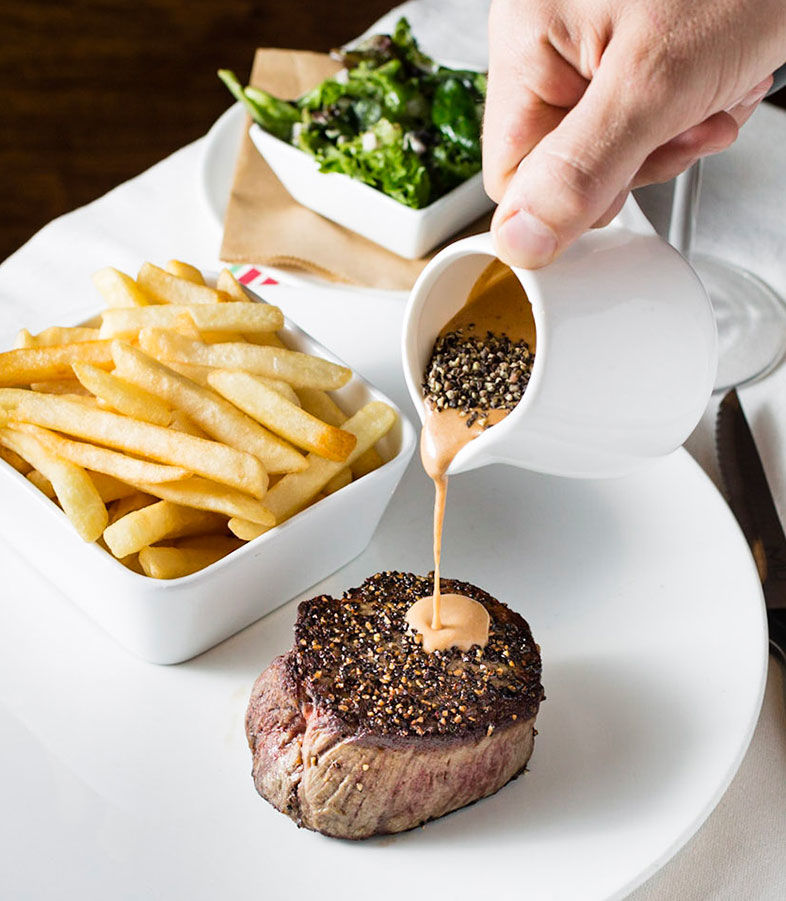
Tapenade’s Sterling French Reputation Remains Near-Perfect at Bistro Du Marché
Beef tenderloin au poivre
Most San Diegans are familiar with what he did next—move to La Jolla in 1998 and open Tapenade with his wife, Sylvie. That upscale French bistro sat near the top of the city’s dining scene for 17 years. Forced to move from Fay Avenue in 2015, Diot and chef de cuisine Miguel Baez reconcepted as Bistro du Marché, a bistronomie (a concept of seasonal, casual dining with highfalutin, refined elements of gastronomy, not unlike America’s casual-gourmet movement of high-end chefs opening un-stuffy, come-as-you-are joints).

Tapenade’s Sterling French Reputation Remains Near-Perfect at Bistro Du Marché
Moules frites
A few gold standards from Tapenade survived the name change, like the country-style pork pâté—Diot’s grandmother’s recipe, the server informs us. Country-style, or pâté de campagne, means the pork meat and liver aren’t as finely ground, so it’s a textural blend of silk and meat. Thanks, Grandma. Theirs is lighter, airier than most country-style terrines, its fat content cut through with Dijon mustard. (Wait, a critique! Not enough mustard!) A salad comes with roasted beets in duck fat and a near-savory goat cheese ice cream, lemon gel, and horseradish gel. This dish embodies the high/low, then/now philosophy of bistronomie—the everyday roasted beet with modern cooking ideas. Another Tapenade classic is the nearly wonton-light ravioli stuffed with a duxelles of 16 different types of mushrooms floating in a foamy broth of port wine, truffles, and cream. If you don’t enjoy this dish, seek medical attention.
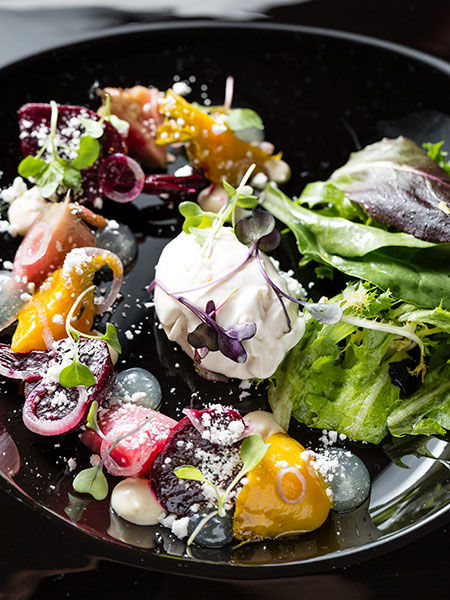
Tapenade’s Sterling French Reputation Remains Near-Perfect at Bistro Du Marché
Salad with baby beets, goat cheese ice cream, duck fat, lemon gel, and horseradish gel
For wine, I always do the same thing: name my price point (circa $60) and ask the sommelier or most capable wine person to pick a bottle that plays well with our orders. Our server selects the cabernet-based Bordeaux, 2011 Château Saint Ahon. The 60-percent cab will pierce the steak, the 30-percent merlot and a bright cherry note mellows it for the halibut.
The grilled octopus is both tender and grilled off for texture, laid among cannellini beans and citrus. Pulled all together in a single bite, it’s harmony. For something unique, try the blue crab and mango salad. A small tower of fresh crab is stacked in a coconut-lime emulsion, evoking the switch in French cooking when France colonized Vietnam. On Tuesdays, it’s moule frites night, and du Marché’s are perfect—each mussel tossed long enough in its white wine broth that you don’t even need to dunk the tiny morsels of meat, although why not? The fries, crisped in peanut oil (the best oil for frying), are infectious. I dunk them in the mussels broth and the hard edges of life melt away.
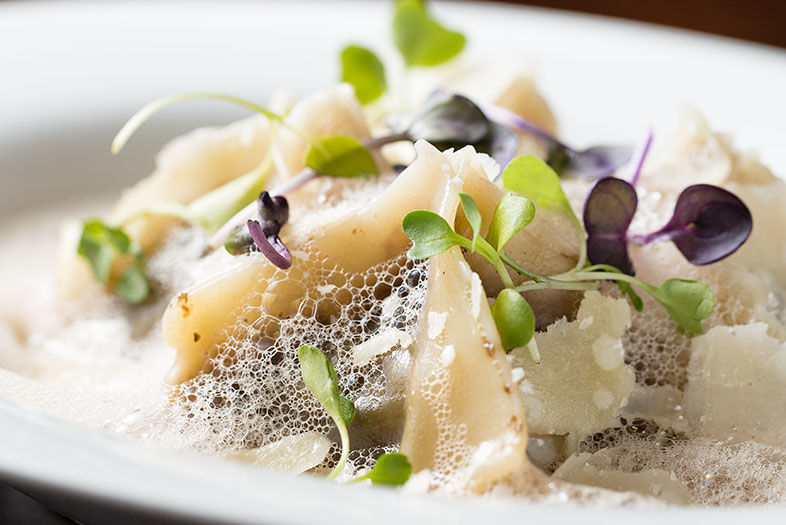
Tapenade’s Sterling French Reputation Remains Near-Perfect at Bistro Du Marché
Ravioli aux champignons with port cream sauce
And here we get to the worst part of our experience at du Marché—that damned creamed spinach. It’s average. Lacks a touch of seasoning, an identity, a wow. It’s acceptable. And acceptable is not acceptable at this point in my du Marché experience. I’m spoiled.
Really, anything on the menu with a sauce is hard to unlove. The beef tenderloin au poivre is tender. Some pepper sauces overdo it, tasting like a food-based pepper spray. Du Marché’s is rich with cream and liquor and umami, with the perfect supporting note of spice. Then there’s the lemon cream sauce on the daily catch (Alaskan halibut), just enough traces of it to accent but not overwhelm the fish. Or the vanilla-lavender foam and mango gel with the Maine diver scallops. Scallops love lavender, but often chefs need a restraining order on their use of it; du Marché’s is balanced, just exotic and sweet enough, with sea beans to lend a natural coastal salinity.
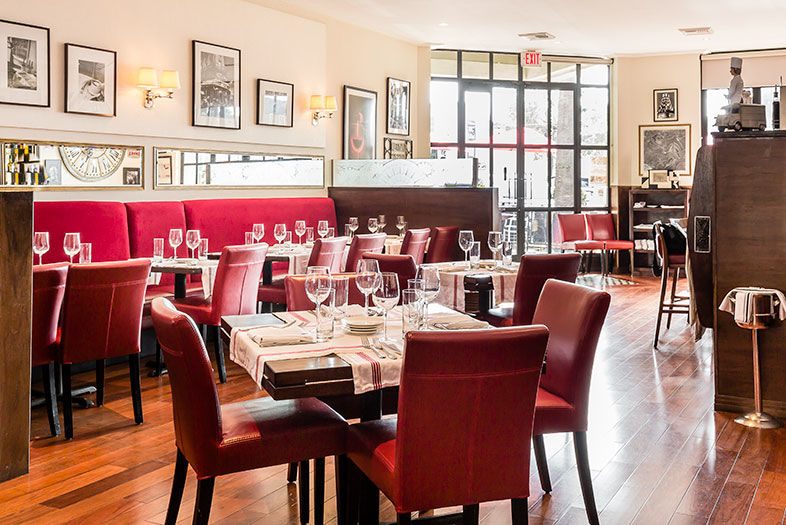
Tapenade’s Sterling French Reputation Remains Near-Perfect at Bistro Du Marché
Justin McChesney-Wachs
Desserts are where I always find fault. Most savory chefs aren’t strong pastry chefs, and few restaurants can afford to pay both. So the chef de cuisine pulls out a couple so-so recipes they remember from culinary school and give it a halfhearted go. And yet, no flaws. At this point I’m a little peeved.
The île flottante (floating islands), a classic French dessert, has air-soft meringue adrift in crème anglaise and caramel sauce with toasted almonds. It tastes like Michelin stars. The profiteroles are coated in a dark chocolate sauce and stuffed with Grand Marnier ice cream, and the seasonal clafouti—another French classic, and easy to mess up—has spiced apples, creamy inside like a soufflé.
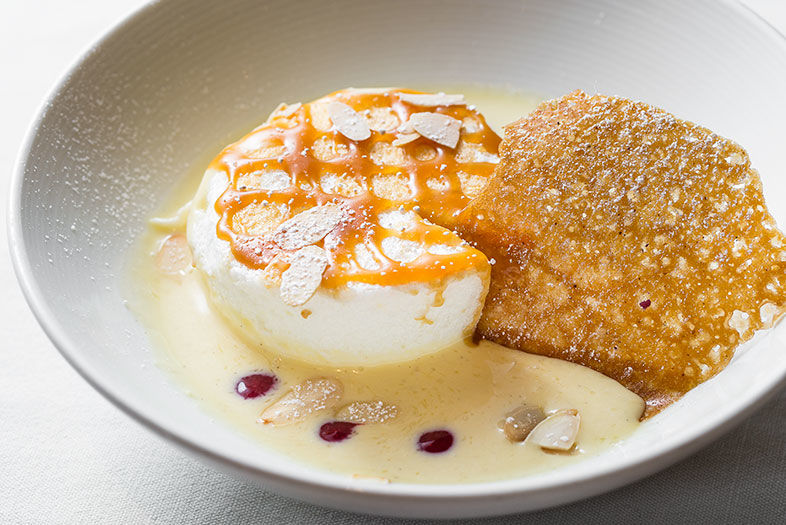
Tapenade’s Sterling French Reputation Remains Near-Perfect at Bistro Du Marché
île flottante dessert with meringue, caramel sauce, crème anglaise, and toasted almonds
When the Diots took their French heritage a few blocks over, and a touch out of the way, I hoped it wasn’t the beginning of the end. And with each bite of a new dish, my friend and I—he being a usual suspect who’s been with me on many, many review dinners—looked at each other with awe. The name and the room have changed, but the talent of Diot and Baez is as strong as ever.
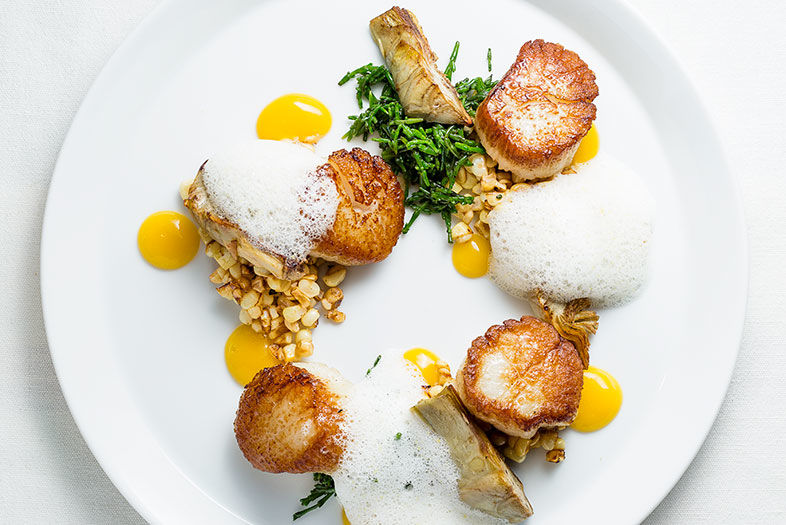
Tapenade’s Sterling French Reputation Remains Near-Perfect at Bistro Du Marché
PARTNER CONTENT
Saint Jacques du Maine scallops with roasted corn, asparagus, sea beans, vanilla lavender foam, and mango gel.

